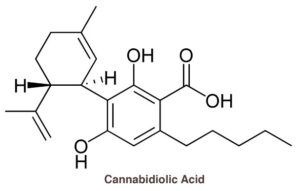EDUCATION Cannabis

Increasing awareness through education
At Coffeeshop de Loods, we place enormous value on cannabis education. We believe it's important that people are well-informed about the effects of cannabis and the potential risks that using cannabis products can bring. We strive to provide you with honest information so you can make conscious choices about whether or not to use cannabis.
What is Cannabis?
Cannabis is a natural product from the Cannabis sativa plant. Various cultures have different names for it, such as marijuana, weed, or stuff (hash). Essentially, marijuana consists of the dried flower tops of the cannabis plant.
Hashish, or hash, is made by sifting the resin from these flower tops and then pressing it into a concentrated block. The many different effects of cannabis use are often summarized with the terms being 'high' or 'stoned'. The main substance that causes these effects is THC, or tetrahydrocannabinol. Each different type of hash or weed contains different levels of that THC. Besides THC, terpenes are also important for the taste, smell, and effect of a particular cannabis strain. Terpenes are natural substances in plants. Take a lavender plant, for example. If you run your hand along it and smell, you'll encounter the terpenes on your hand. This is also the case with cannabis, and these terpenes also have a determining factor in the effect.
Cannabis Effects
Hash and weed are soft drugs with diverse effects, such as pain-relieving properties and suppressing emotions. The different strains can each give a different type of effect. Cannabis can also intensify certain feelings and lower blood pressure or increase it. It can make you sluggish and you can suddenly get enormous munchies. Be careful though, because it can also change the way you experience the world around you. When you add that it can slow down your reactions to what's happening around you, you understand why you shouldn't drive a car after using cannabis. Cannabis and traffic do NOT go together.
As part of our policy to make customers more aware, we see it as our duty to point out the risks associated with consuming cannabis, in any form: whether you smoke it, vape it, or eat it. Customers may have trouble thinking logically and experience memory problems, such as forgetting what happened a few minutes ago. Smoking cannabis puts tar in your lungs and that can be harmful. Another risk is called a 'bad trip' or 'going bad'. If you use too much cannabis at once, for example, or if you felt weak or depressed before using it, you may experience symptoms such as heart palpitations, excessive sweating, loss of control, nausea, anxiety, and paranoia. You should always use cannabis responsibly. Continuous use can lead to addiction, both physical and mental. Some people are extra vulnerable to the negative effects, such as people who are susceptible to depression and psychosis. Also never drink alcohol before or after using cannabis, because the combination of alcohol and cannabis can lead to unpredictable and very unpleasant mental and physical reactions.
If you have little or no experience with cannabis, stick to the following guidelines to keep your experience as positive and relaxed as possible. First, always ask the coffeeshop staff for a mild cannabis strain to try. Some cannabis strains have a higher THC content, making them too strong for beginners. Second: start slowly. It takes a few minutes before you start feeling the effects of THC after smoking it. Therefore, don't immediately smoke everything at once after rolling or buying a joint. Light it calmly, take a few (about 2) puffs, and then put the joint down again. Wait about ten minutes until you start feeling the effects. If you feel okay, you could repeat this. If you choose so-called 'edibles', or edible cannabis products, such as space cake, you need to wait longer for the effect to become noticeable. This is because THC takes about 45 minutes to sometimes up to 2 hours to reach your brain through your stomach. Because when eating cannabis the full THC is absorbed into the body, the effect can be experienced more strongly. This effect can last up to about 6 hours. Therefore, don't eat your edibles all at once: eat half first and be patient. In case of a 'bad trip', you could take a CBD product to somewhat counteract the effect.
Depending on how you enjoy a cannabis product, the effects begin to occur from a few minutes to an hour after use. Customers who prefer smoking notice the effect after just a few minutes: this can remain noticeable for about several hours. If you prefer to eat our products, keep in mind that it can take up to one to two hours before you start feeling anything. From that moment, the effects can remain noticeable for about four to eight hours. The effects of cannabis use can be divided into mental or psychological effects and physical effects. Always remember that all these effects are only temporary: after a while they will go away on their own. If you don't feel well after using cannabis, just try to relax and find a quiet place where you can wait until you feel better again. Alcohol-free drinks with lots of sugar often help against the symptoms, as does having someone you trust nearby to reassure you.
Hash and weed influence how you feel and how you perceive the world around you. You may start feeling cheerful and relaxed. You may forget your worries and find it easier to connect with other people. On the other hand, some people experience strong feelings of anxiety and paranoia, which is also called 'going bad' or a 'bad trip'. You may start experiencing music and colors more intensely. The way you experience time and space can change. Cannabis can stimulate your imagination, but you may also find it difficult to concentrate on what's happening around you. Logical thinking can become more difficult and your memory may work less well. You might suddenly forget what you actually wanted to say in the middle of a sentence.
Cannabis can make you feel physically very good and relaxed. On the other hand, you can also feel unpleasant from it. Your heart rate might go up and you can get heart palpitations. You can become dizzy and feel faint because your blood pressure goes down. You can get a dry mouth that makes you thirsty, and your eye whites can become pink or a bit red because your blood vessels dilate. Your limbs can feel heavy because your muscles relax. You can get serious munchies, especially for sweets and snacks with lots of sugar. Again: remember that all these effects are only temporary: they will go away on their own after a while. If you're with someone who is 'going bad', becoming paranoid, or maybe fainting ('going out') after using cannabis, stay nearby to reassure them, give sugar water (or cola). Sleeping or resting is then a good option. Because cannabis affects your mood, you may start feeling like you're really very sick or even dying, but that's not the case. You're just having a 'bad trip', and with a bit of fresh air, a quiet place to recover.
Remember that your mood becomes more intense when you use cannabis, so if you're not feeling so good already, cannabis can make that worse. Make sure you only use cannabis when you feel cheerful and relaxed. Using cannabis on an empty stomach can make you feel extra faint or nauseous, so always make sure you've eaten something first. Your environment is also a factor. Find a quiet and relaxed place where you feel comfortable before using cannabis. It's often good to use it in the company of friends you trust. Another useful tip: make sure you have something tasty and sweet to eat nearby in case you suddenly get a 'munchie attack'. Also prepare enough drinks for thirst and a dry mouth.
As a responsible cannabis business, we at Boerejongen find it very important that you use cannabis products responsibly. If you want to know whether your own cannabis use keeps the risks as small as possible, fill out this online test: test. The test was developed by Jellinek, the experts when it comes to drugs and drug use. After answering the questions, you can view the results with additional information and your score. We also give you our professional recommendations and tips to keep it safe in the future. If you need help and advice with stopping cannabis, the following sites can be useful: Addaction.org.uk (UK) Drugabuse.gov (USA) emcdda.europa.eu (Germany) www.jellinek.nl (Netherlands) You can of course also always approach our trained staff with your questions – we're here for you!
Cannabinoids: an Introduction
CANNABIS IS A NATURAL PRODUCT THAT CONTAINS A WIDE RANGE OF ACTIVE SUBSTANCES, THE MOST IMPORTANT OF WHICH ARE CALLED CANNABINOIDS.
These cannabinoids are structurally similar to substances that occur naturally in our body, namely endocannabinoids. Both cannabinoids and endocannabinoids can influence our nervous system, mainly in the brain. This explains why they can affect our feelings, thoughts, and perception. Understanding the basic principles of cannabinoids will help you better understand what you’re actually using, and this will in turn help when choosing cannabis strains that match your personal preferences. Cannabis use can be recreational, but also for medical purposes, depending on the different amounts of cannabinoids present in it. Your experience with cannabis depends entirely on the strain you buy. The explanation below will help you understand the differences between the various cannabis strains we sell. Knowing and understanding cannabinoids and their effects will help you make an informed choice for responsible cannabis use.
CANNABINOIDS
THC AND CBD ARE THE TWO MOST COMMON CANNABINOIDS IN MARIJUANA, BUT THEY EACH HAVE A DIFFERENT ROLE.
THC is psychoactive and plays an important role in experiencing a “high” or “stoned” feeling. In contrast, CBD has a dampening effect on this experience, reducing the psychoactive effect and increasing the medicinal value of the strain. THC is the most well-known cannabinoid in cannabis and is mainly used recreationally. However, the popularity of marijuana for medical purposes comes mainly from the presence of other active cannabinoids. An important active ingredient that people with medical conditions are particularly interested in is cannabidiol or CBD. These active components occur in different ratios in different cannabis strains, giving each strain unique applications.
THC
This cannabinoid is the most well-known and most common in cannabis. It has the scientific name delta-9-tetrahydrocannabinol, or THC. THC is responsible for the main psychoactive effects that occur when you use cannabis. It stimulates parts of the brain that release dopamine, which can cause feelings of euphoria and well-being. Additionally, it provides deep relaxation and a sluggish, drowsy feeling, contributing to the “high” experience. THC also has pain-relieving properties and may possibly help reduce pain complaints and inflammation. However, it’s important to avoid excessive cannabis use.
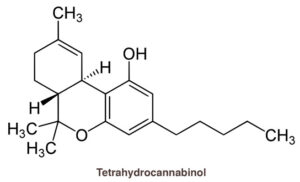
CBD
CBD, short for cannabidiol, is often the second most common cannabinoid in cannabis. It has great appeal as a supplement and is therefore highly sought after, especially among medical users. CBD is mainly extracted from industrial hemp plants for supplements. Unlike THC, this substance has no psychoactive effects, but it would actually reduce and regulate the effects of THC. This allows strains with both high THC and CBD levels to cause a clearer mental high, compared to heavier, more sedating cannabis strains with little CBD. CBD itself has a long list of versatile positive properties. It’s claimed that CBD can help against symptoms such as chronic pain, inflammation, migraine, rheumatism, spasms, epilepsy, and schizophrenia. As more research is conducted, new applications are constantly being discovered.

CBN
Cannabinol, or CBN for short, is a painkiller that forms when THC is broken down by oxidation. Although CBN is mildly psychoactive, it only occurs in small amounts in fresh cannabis plants. The formation of CBN can also be prevented by storing the cannabis in a cool and dark place after harvest. Generally, people prefer the effects of THC over those of CBN, because CBN is less potent and can cause considerable drowsiness, especially in high concentrations. However, CBN is also known to reduce anxiety and can help with pressure behind the eyes.
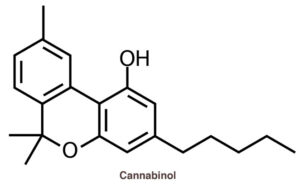
CBG
CBG, also known as cannabigerol, is an active cannabinoid known for its antibacterial properties. For a long time, it was thought that CBG didn’t occur much in most cannabis strains. However, recent research has shown that CBG probably functions as a precursor or “stem cell” for CBD and THC. This means that both THC and CBD originally start as CBG. Additionally, it has been found that CBG inhibits GABA uptake. GABA is a neurotransmitter in the human brain, involved in signal transmission in our nervous system. When GABA uptake is blocked, this gives a relaxed feeling that is also associated with CBD. This discovery has led to more research into this cannabinoid, as it may prove to be of great importance.
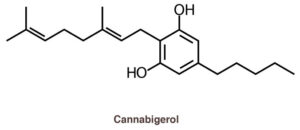
Tetrahydrocannabivarine, or THCV, is considered a cannabinoid that regulates the intensity of the psychoactive effects of THC. Currently, research is being conducted into the possible application of THCV in treating metabolic diseases and reducing appetite. However, it’s important to note that THCV only occurs in very small amounts in a normal cannabis plant.
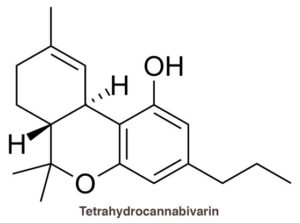
Cannabichromene, or CBC, is believed to have anti-inflammatory and pain-relieving properties, although not much medical research has been done on this cannabinoid yet. Nevertheless, recent studies suggest that this substance may possibly play an important role in cell regeneration.
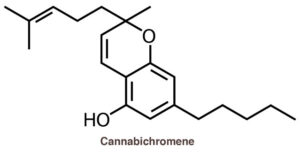
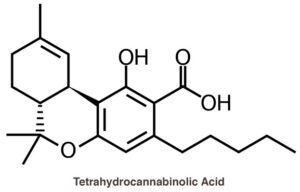 THCA is the acid form of THC. This is the raw form in which THC occurs in fresh cannabis plants. When cannabis is heated, THCA is converted to THC. In its raw form, THCA is not considered an active cannabinoid.
THCA is the acid form of THC. This is the raw form in which THC occurs in fresh cannabis plants. When cannabis is heated, THCA is converted to THC. In its raw form, THCA is not considered an active cannabinoid.
CBDA, also known as cannabidiolic acid, is the acid form of CBD, similar to how THCA is the acid form of THC. It reportedly has the property of counteracting nausea and could possibly help in fighting breast cancer. However, more research is needed to gain better insight into the medicinal properties of this substance.
